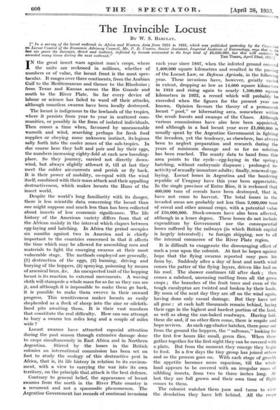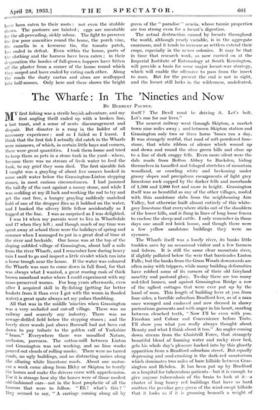The Invincible Locust
I3v W. S. BARCLAY.
[" In a survey of the locust outbreak in Africa and Western Asia from 1925 to 1931, which was published yesterday by the Commi on Locust Control of the Economic Advisory Council, Mr. P. B. Uvarov, Senior Assistant, Imperial Institute of Entomology, says that in the tan *ix years the damages, direct and indirect, inflicted by locusts amounted to the huge total of £6,000,000, but this will certainly 64 exceeded many times during the next outbreak." Tax Maas, April 22nd, 1933.] .
IN the great insect wars against man's crops, where the units are reckoned in millions, whether of numbers or of value, the locust front is the most spec- tacular. It ranges over three continents, from the Arabian Gulf to the Mediterranean and thence to the Rhodesias ; from Texas and Kansas across the Rio Grande and south to the River Plate. So far every device of labour or science has failed to ward off their attacks, although countless swarms have been locally destroyed.
The locust is indigenous to the lowlands of the tropics, where it persists from year to year in scattered com- munities, or possibly in the form of isolated individuals. Then comes a time when, favoured by unseasonable warmth and wind, searching perhaps for fresh food supplies or obeying some unknown instinct, its legions sally forth into the cooler zones of the sub-tropics. In due course here they halt and pair and lay their eggs, the numbers increasing eighty-fold at each new breeding- place. So they journey, carried not directly down- wind, but always slightly, athwart it, till at last they meet the colder air-currents and perish or fly back. It is their power of mobility, co-equal with the wind itself, combined with their mass attack and their appalling destructiveness, which makes locusts the Huns of the insect world.
Despite the world's long familiarity with its danger, there is less scientific data concerning the locust than one might suppose and much less than has been collected about insects of less economic significance. The life history of the American variety differs from that of the African mainly in the interval which elapses between egg-laying and hatching. In Africa the period occupies six months against two in America and is chiefly important to the countries concerned in that it affects the time which may be allowed for assembling men and materials to fight the emerging swarms at their most vulnerable stage. The methods employed are generally, (1) destruction of the eggs, (2) burning, driving and burying of the hoppers, (3) spraying, poisoning by means of arsenical bran, &c. An unexpected trait of the hopping locust is its reaction to external movements. A waving cloth will stampede a whole mass for as far as they can see it, and although it is impossible to make them go back, it is possible to make them swerve in their onward progress. This sensitiveness makes locusts as easily shepherded as a flock of sheep into the zinc or oilcloth- lined pits awaiting them. It is their vast numbers that constitute the real difficulty. How can one attempt to bury a swarm ten miles long and a couple of miles wide ?
Locust swarms have attracted especial attention during the past season through extensive damage done to crops simultaneously in East Africa and in Northern Argentina. Stirred by the losses in the British colonies an international commission has been set on foot to study the ecology of this destructive pest in Africa, that is, its life history in relation to its environ- ment, with a view to carrying the war into its own territory, on the principle that attack is the best defence.
Contrary to general belief, the appearance of locust swarms from the north in the River Plate country is a recurrent and not a spasmodic phenomenon. The Argentine Government has records of continual invasions each year since 1897, when the infested ground covered 1,400,000 square kilometres and resulted in the passing of the Locust Law, or Defensa Agricola, in the following year. These invasions have, however, greatly varied in extent, dropping as low as 14,000 square kilometres in 1913 and rising again to nearly- 1,500,000 square kilometres in 1922; a record 'which will probably be exceeded when the figures for the present year are known. Opinion favours the theory of a permanent locust " pool," or hibernating area, somewhere within the scrub forests and swamps of the Chaco. Although various commissions have also here been appointed, and although in a bad locust year over £1,000,000 is usually spent by the Argentine Government in fighting the invaders, yet the tendency, as elsewhere, has always been to neglect preparation and research during the years of minimum damage and so far no solution has been reached. The scanty data to hand from this area points to the cycle—egg-laying in the spring ; hatching, without embryonic diapause ; prolonged in- activity of sexually immature adults ; finally, renewed egg.. laying. Locust losses in Argentina and the bordering republic of Uruguay have this year been appreciable. In the single province of Entre Rios, it is reckoned that 400,000 tons of cereals have been destroyed, that is, have not come to harvest. The total losses in the invaded areas are probably not less than 2,000,000 tons of cereal and other annual crops, with a. potential value of £10,000,000. Stock-owners have also been affected, although in a lesser degree. These losses do not include expenditure by Government nor the consequential losses suffered by the railways (in which British capital is largely interested) ; to foreign shipping, nor to all the internal commerce of the River Plate region.
It is difficult to exaggerate the discouraging effect of such a year upon the colonist. At first he hopes against hope that the flying swarms reported may pass his farm by. Suddenly after a day of heat and north wind comes the patter of the flying layers, driven like hail on his roof. The shower continues till after. dark ; then comes a subdued, unceasing rustling from all the green crops ; the branches of the fruit trees and even of the tough eucalyptus are twisted and broken by their loads. By noon of the next day they are off on the wind again, having done only casual damage. But they have not all gone : at each halt thousands remain behind, laying their eggs in the highest and hardest portion of the land, as well as along the sun-baked roadways. Having laid, these die and, if no other fliers come, there is respite and hope revives. As each egg-cluster hatches, there pour out from the ground the hoppers, the " saltonas," looking for the first few hours like small, green flies. When these gather together for the first night they can be covered with a plate. But from the moment they emerge they begin to feed. In a few days the tiny group has joined others and so the process goes on. With each stage of growth the appetite becomes more rapacious, till the whole land appears to be covered with an irregular mass of nibbling insects, from two to three inches long. At last they are full grown and their own time of flight comes to them.
The colonist watches them pass and turns to view the desolation they have left behind. All the crops have been eaten to their roots : not even the stubble shows. The pastures are tainted ; eggs are uneatable for the all-pervading, sickly odour. The fight to preserve the few poor amenities round the home, the porch vine, the camelia in a kerosene tin, the tomato patch, has ended in defeat. Even within the house, parts of the clothing and the harness have been eaten ; in their desperation the hordes of full-grov►ni hoppers have bitten off the plaster from a corner of the house round which they surged and have ended by eating each other. Along the roads the dusty cactus and aloes are seallopped into half-moons. Only here and there • shows the bright green of the " paradise " acacia, whose tannic properties are too strong even for a locust's digestion.
The actual destruction caused by locusts throughout the world, although yearly variable, is in the aggregate enormous, and it tends to increase as settlers extend their crops, especially in the newer colonies. It may be that in time that research work, as now carried on at the Imperial Institute of Entomology at South Kensington, will provide a basis for some major locust-war strategy, which will enable the offensive to pass from the insect to man. But for the present the end is not in sight, and the locust still lurks in the wilderness, undefeated.







































 Previous page
Previous page